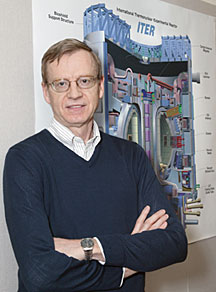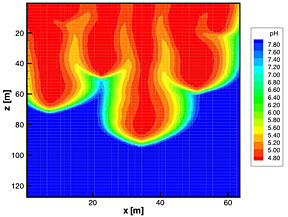| Research
|
DOE Princeton Plasma Physics Laboratory (PPPL) physicist Dave Johnson has been named the U.S. ITER Diagnostics Team Leader. ITER (Latin for “the Way”) is a large international fusion experiment aimed at demonstrating the scientific and technological feasibility of fusion energy — the power source of the sun and the stars. Diagnostic systems on ITER will measure the properties of plasma, the hot ionized gas that serves as the fuel for fusion energy production. ITER will employ a myriad of these devices. Johnson is a world-class authority in the design of plasma diagnostic instruments, effective in the management and implementation of such systems, and experienced in the complex multi-cultural environment of ITER. In addition to the U.S., ITER partners include Europe, Russia, Japan, India, South Korea, and China. Johnson is responsible for managing the design and procurement of the diagnostic devices to be supplied to ITER by the U.S. team. “The U.S. is allocated 16 percent of the total diagnostics responsibility for ITER — the second largest role next to Europe's,” said Johnson. “I'm very happy with this allocation.” His first responsibility was to pull together the cost estimates for the diagnostics. In addition, he has been involved in international working groups considering how to procure the diagnostic devices and the shield plugs that provide these devices with access to the plasma and also provide a radiation shield for the surrounding areas. Johnson is well prepared for the tasks ahead. Since 1997, he has served as Division Head responsible for diagnostic development in support of the fusion facilities at PPPL and around the world. He has managed diagnostic development for the National Spherical Torus Experiment (NSTX) at PPPL, typically implementing several new diagnostics each year, many in collaboration with researchers from other institutions. He has led the planning for diagnostics for the National Compact Stellarator Experiment (NCSX), which is being constructed at PPPL in partnership with Oak Ridge National Laboratory. ITER is being built in Cadarache, France, and will begin operation in 2016. It is expected to operate for 20 years.Submitted by DOE's Princeton Plasma Physics Laboratory |
||||||||||||||||||||||
|
Check out the Office of Science's new Website.
|
Collaboration to develop computer model for studying subsurface processesA team of scientists at DOE's Los Alamos National Laboratory, along with researchers at Argonne National Laboratory, Oak Ridge National Laboratory, and Pacific Northwest National Laboratory, and the University of Illinois at Urbana-Champaign, are working to develop a powerful new massively parallel computer model called PFLOTRAN for use in studying subsurface processes. The Multiscale-Multiphase-Multicomponent Subsurface Reactive Flows modeling effort is designed to provide computer modeling capabilities at various spatial and temporal scales. The model will enable geoscience researchers to obtain more accurate predictive capabilities for underground contaminant transport.
According to Los Alamos' Peter Lichtner, principal investigator for the project, "predictive modeling of reactive subsurface flows is often a daunting task, chiefly because of the range of spatial scales that are involved-from the tiniest pores in the rock to field scales-and the range of time scales involved-from seconds to millions of years. Usually, large-scale three-dimensional models can only resolve features down to the order of meters, which makes capturing smaller scale phenomena, such as millimeters or less, difficult. The modeling process we propose is designed to change that by providing modeling capabilities at various spatial scales" The PFLOTRAN model is already being applied by Los Alamos scientists to study CO2 injection at the SACROC Unit in West Texas in a collaboration with New Mexico Institute of Mining and Technology. Owned by Kinder Morgan Energy Partners, SACROC is one of the oldest and largest oil fields in the U.S. utilizing CO2 injection technology to enhance recovery. Applications for the model will include CO2 sequestration at various locations, including SACROC, and enhanced modeling capabilities aimed at improving understanding of radionuclide migration at the 300 Area of the Hanford facility in Washington state, where sub-millimeter-scale underground contaminant transport effects have thwarted previous remediation efforts. The project was recently awarded $4 million through a SciDAC (Scientific Discovery through Advanced Computing) grant from DOE's Office of Science.Submitted by DOE's Los Alamos National Laboratory |




